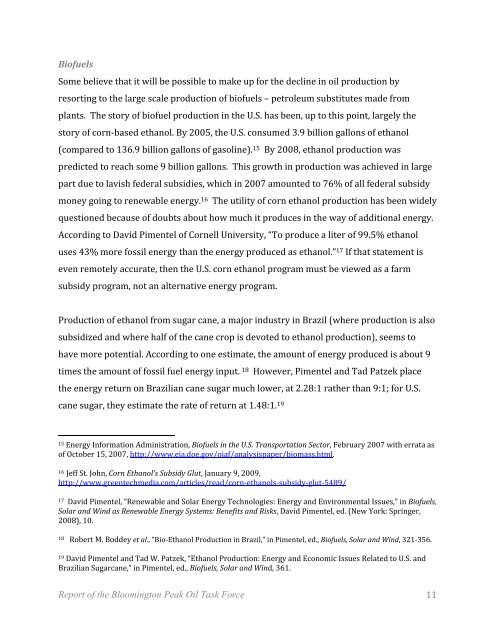Peak Oil Task Force Report - City of Bloomington - State of Indiana
Peak Oil Task Force Report - City of Bloomington - State of Indiana
Peak Oil Task Force Report - City of Bloomington - State of Indiana
You also want an ePaper? Increase the reach of your titles
YUMPU automatically turns print PDFs into web optimized ePapers that Google loves.
Bi<strong>of</strong>uels<br />
Some believe that it will be possible to make up for the decline in oil production by<br />
resorting to the large scale production <strong>of</strong> bi<strong>of</strong>uels – petroleum substitutes made from<br />
plants. The story <strong>of</strong> bi<strong>of</strong>uel production in the U.S. has been, up to this point, largely the<br />
story <strong>of</strong> corn‐based ethanol. By 2005, the U.S. consumed 3.9 billion gallons <strong>of</strong> ethanol<br />
(compared to 136.9 billion gallons <strong>of</strong> gasoline). 15 By 2008, ethanol production was<br />
predicted to reach some 9 billion gallons. This growth in production was achieved in large<br />
part due to lavish federal subsidies, which in 2007 amounted to 76% <strong>of</strong> all federal subsidy<br />
money going to renewable energy. 16 The utility <strong>of</strong> corn ethanol production has been widely<br />
questioned because <strong>of</strong> doubts about how much it produces in the way <strong>of</strong> additional energy.<br />
According to David Pimentel <strong>of</strong> Cornell University, “To produce a liter <strong>of</strong> 99.5% ethanol<br />
uses 43% more fossil energy than the energy produced as ethanol.” 17 If that statement is<br />
even remotely accurate, then the U.S. corn ethanol program must be viewed as a farm<br />
subsidy program, not an alternative energy program.<br />
Production <strong>of</strong> ethanol from sugar cane, a major industry in Brazil (where production is also<br />
subsidized and where half <strong>of</strong> the cane crop is devoted to ethanol production), seems to<br />
have more potential. According to one estimate, the amount <strong>of</strong> energy produced is about 9<br />
times the amount <strong>of</strong> fossil fuel energy input. 18 However, Pimentel and Tad Patzek place<br />
the energy return on Brazilian cane sugar much lower, at 2.28:1 rather than 9:1; for U.S.<br />
cane sugar, they estimate the rate <strong>of</strong> return at 1.48:1. 19<br />
15 Energy Information Administration, Bi<strong>of</strong>uels in the U.S. Transportation Sector, February 2007 with errata as<br />
<strong>of</strong> October 15, 2007, http://www.eia.doe.gov/oiaf/analysispaper/biomass.html.<br />
16 Jeff St. John, Corn Ethanol’s Subsidy Glut, January 9, 2009,<br />
http://www.greentechmedia.com/articles/read/corn‐ethanols‐subsidy‐glut‐5489/<br />
17 David Pimentel, “Renewable and Solar Energy Technologies: Energy and Environmental Issues,” in Bi<strong>of</strong>uels,<br />
Solar and Wind as Renewable Energy Systems: Benefits and Risks, David Pimentel, ed. (New York: Springer,<br />
2008), 10.<br />
18 Robert M. Boddey et al., “Bio‐Ethanol Production in Brazil,” in Pimentel, ed., Bi<strong>of</strong>uels, Solar and Wind, 321‐356.<br />
19 David Pimentel and Tad W. Patzek, “Ethanol Production: Energy and Economic Issues Related to U.S. and<br />
Brazilian Sugarcane,” in Pimentel, ed., Bi<strong>of</strong>uels, Solar and Wind, 361.<br />
<strong>Report</strong> <strong>of</strong> the <strong>Bloomington</strong> <strong>Peak</strong> <strong>Oil</strong> <strong>Task</strong> <strong>Force</strong><br />
11









